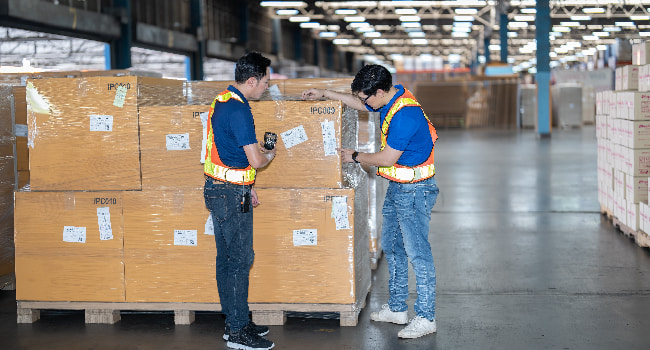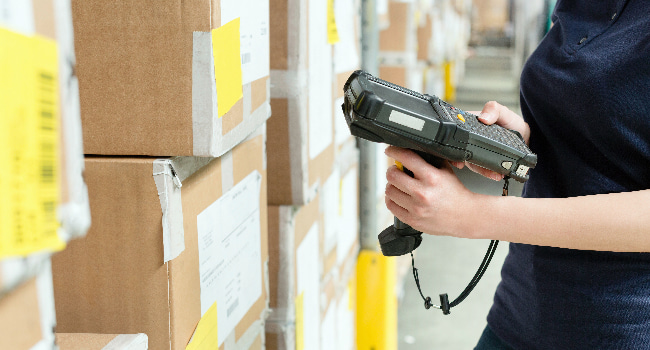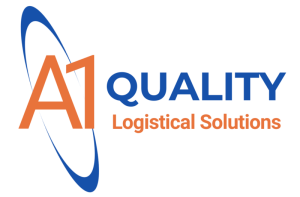A1 Quality Logistical Solutions

- By Haley
- August 21, 2025
Table of Contents
Key Highlights
- Accurate product labeling is a cornerstone of supply chain efficiency, enabling reliable inventory management and streamlined logistics operations.
- High labeling accuracy directly supports order fulfillment, minimizing shipping errors and driving customer satisfaction.
- Proper inventory tracking through consistent labeling helps businesses avoid stockouts, excess inventory, and costly reconciliation issues.
- Regulatory compliance is simplified when labels are accurate, reducing the risk of fines and delays.
- Enhanced labeling practices allow for seamless integration with ecommerce platforms and logistics providers, supporting multi-channel growth.
Introduction
Product labeling is much more than sticking a barcode on a box. In today’s supply chain, it’s a vital process that influences every stage of logistics operations. Accurate labels allow you to track products, fulfill orders swiftly, and keep inventory records precise. When labeling falls short, costly mistakes ripple across your business. How does this impact your operations—and what steps can you take to improve accuracy? Let’s explore the essential role of product labeling services in modern supply chains.
Understanding Product Labeling Services in the Supply Chain
Product labeling services are integral to supply chain management, powering everything from inbound receiving to outbound shipping. These services make it easier for logistics providers and warehouse teams to identify, sort, and reconcile inventory. When labels are reliable, operational efficiency rises—stock moves quickly, orders are fulfilled accurately, and customer service improves. Businesses leveraging professional labeling solutions gain a real advantage in controlling costs and building trust with end-users.
Let’s dig deeper into how labeling plays out in logistics operations, including its role, types, and key business functions.

The Role of Product Labeling in Modern Logistics
Every logistics operation relies on accurate product labeling. When a product arrives at a fulfillment center, a correct label ensures it’s scanned, entered into inventory, and tracked throughout its journey. This precision supports order fulfillment—if labels are wrong, orders ship incorrectly and customers get frustrated.
Inventory tracking depends on reliable label data. “Inventory accuracy means your physical stock matches the records in your system, which is vital for avoiding costly errors,” says Brad Bearden, Product Manager of Acctivate Inventory Software. For your business, this means fewer lost items and faster processing.
Customer experience also hinges on labeling accuracy. Orders are delivered on time when inventory is easy to locate and track. When products are mislabeled, it can lead to stockouts or delays, hurting customer satisfaction and your reputation. Accurate labeling helps maintain high inventory accuracy—a key metric for supply chain success.
Types of Labels Used Across Different Industries
Businesses across industries use a variety of label types to manage products and streamline logistics. The choice often depends on your business model, ecommerce platform, or the logistics provider you partner with.
- Barcode labels: Common in warehousing for fast scanning and automated inventory tracking.
- RFID tags: Used for real-time tracking and advanced inventory visibility.
- Serial number labels: Essential for electronics, health, and beauty products requiring traceability.
- Shipping and compliance labels: Required for food, beverage, and regulated goods to meet legal standards.
Ecommerce platforms like Shopify or Amazon often require barcode or RFID labels for rapid fulfillment. Logistics providers prefer standardized formats to simplify inbound and outbound processes. Choosing the right label type impacts your supply chain speed and accuracy.
Key Functions of Product Labeling for Businesses
Labeling fulfills several essential roles for business operations. First, it ensures order accuracy—when products are clearly labeled, picking and packing errors drop dramatically. This supports both inventory management and customer service.
Proper labeling also supports regulatory compliance. Food, health, and beauty industries face strict labeling rules. Accurate labels make audits smoother and reduce the risk of costly fines.
Finally, labeling helps reconcile inventory. Warehouse teams rely on clear, consistent labels to track movement, count stock, and update records in real-time. When labeling processes slip, order delays and mismatches become common, hurting customer satisfaction and raising operational costs. Effective product labeling is critical for smooth supply chain operations.
Defining Accuracy in Product Labeling
Accuracy in product labeling is measured by the consistency between label information and the actual product. The accuracy rate is a key supply chain management metric—it tracks how often products are labeled correctly versus recorded inventory. High labeling accuracy ensures your records, picking processes, and order fulfillment are reliable. When accuracy dips, errors multiply, impacting both operations and your bottom line.
Let’s clarify what defines accurate labeling, explore common causes of errors, and explain how accuracy is measured.

What Constitutes Accurate Labeling?
Accurate labeling means every product is marked with correct information—SKU, barcode, quantity, and compliance data. The accuracy rate is calculated by comparing labeled items to expected inventory records. When labeling is consistent, order processing improves, and customer satisfaction rises.
For your business, accurate labels mean fewer order mistakes and greater inventory control. Customers expect to receive what they ordered; mismatches hurt your brand and lead to costly returns. Consistency in labeling also supports regulatory compliance, making audits smoother and avoiding legal trouble.
Common Causes of Labeling Errors
Labeling errors can cripple supply chain performance and are usually due to a handful of recurring issues. Human error and manual mistakes are frequent culprits, especially in fast-paced environments.
- Manual data entry: Typos or skipped fields lead to incorrect or missing labels.
- Misreading product specs: Employees may select the wrong SKU or batch code.
- Inconsistent label formats: Using varying templates confuses pickers and packers.
- Poor training: Staff unfamiliar with labeling software or standards make avoidable mistakes.
- Technology glitches: Outdated barcode scanners or faulty printers cause unreadable labels.
How Labeling Accuracy is Measured
Labeling accuracy is tracked using standard inventory formulas. The inventory accuracy rate compares counted units to units on record:
Metric | Formula |
Inventory Accuracy Rate | (Counted Units / Units on Record) x 100 |
Valuation Accuracy | (Actual Inventory Value / Expected Value) x 100 |
Best practices recommend weekly or cycle counts, comparing physical stock to digital records. Discrepancies are investigated and resolved, improving future accuracy. Technology such as barcode scanners and inventory management systems automates much of this process, reducing manual errors.
Why Label Accuracy Matters to Your Supply Chain
Labeling accuracy touches every part of your supply chain, from inventory management to customer satisfaction. When labels are reliable, inventory tracking is seamless and orders ship with precision. Inaccuracies, however, lead to stockouts, fulfillment delays, and unhappy customers. For a business aiming to grow, investing in label accuracy pays dividends across logistics, finance, and customer experience.
Dive into how labeling impacts inventory tracking, order fulfillment, and regulatory compliance.

Impact on Inventory Management and Tracking
Inventory management depends heavily on accurate labeling. Each product is identified, tracked, and counted based on its label, forming the backbone of inventory data and reconciliation.
- Accurate labels simplify inventory tracking, making it easy to monitor stock levels and prevent shortages.
- Inventory reconciliation is faster when records match physical counts, lowering audit times.
- Data-driven decisions depend on reliable labels—forecasting, restocking, and order processing all use label data.
- Consistent labeling supports integration with inventory management systems, automating updates and reducing manual work.
Effects on Order Fulfillment and Customer Satisfaction
Order fulfillment is only as accurate as your labeling. When labels are precise, fulfillment centers pick, pack, and ship the right items, enhancing customer experience.
Poor inventory accuracy from mislabeling results in wrong or delayed shipments, frustrating customers and increasing return costs. Fulfillment centers rely on clear, scannable labels to process orders quickly. Each labeling error can lead to stockouts—products promised to customers that aren’t actually available.
Labeling Accuracy and Regulatory Compliance
Regulatory compliance is a major concern for supply chain management, especially in food, health, and beauty sectors. Accurate labeling ensures products meet legal standards for traceability, safety, and consumer information.
Supply chains with poor labeling risk fines, recalls, and legal action. Compliance audits are easier when records and physical products match, thanks to reliable labels. Professional labeling services keep your business ahead of changing regulations, safeguarding your brand and bottom line.
Accurate product labeling isn’t just good practice—it’s essential for operating in regulated industries and maintaining trust with stakeholders.
Methods to Assess Product Labeling Accuracy
Assessing labeling accuracy requires a combination of audit procedures and ongoing measurement. By monitoring the inventory accuracy rate and following best practices, businesses can spot errors early and correct them before they become costly. Consistent audits keep your records aligned with physical inventory, supporting robust supply chain operations.
Explore standard audit methods, calculation formulas, and the best timing for accuracy checks.

Standard Audit Procedures for Label Verification
Auditing your inventory for label accuracy means more than a quick glance. Standard procedures involve systematic checks to ensure every label matches the product and recorded data.
- Physical count: Staff manually count inventory and compare labels to system records.
- Audit procedures: Use a checklist to verify label format, code accuracy, and placement.
- Inventory reconciliation: Investigate and resolve any mismatches found during audits.
- Cycle counting: Divide inventory into zones and count sections regularly for ongoing accuracy.
Calculating Labeling Accuracy: Formulas and KPIs
Labeling accuracy is quantified using key performance indicators (KPIs). The core formula compares counted items to recorded inventory:
KPI Name | Calculation |
Inventory Accuracy Rate | (Counted Units / Units on Record) x 100 |
Valuation Accuracy | (Actual Inventory Value / Expected Value) x 100 |
Perfect Order Rate | (Error-Free Orders / Total Orders) x 100 |
Shrinkage Rate | (Lost Units / Units on Record) x 100 |
Tracking these KPIs provides insight into labeling effectiveness. Businesses monitor accuracy rates, perfect order percentages, and shrinkage to identify trends and target areas for improvement.
Frequency and Timing of Label Accuracy Audits
Determining how often to audit labeling depends on product volume, turnover rate, and business model. Cycle counting allows for frequent, targeted checks—ideal for high-value or fast-moving SKUs. Full audits, done monthly or quarterly, help reconcile inventory and catch systemic issues.
Inventory accuracy improves when audits are scheduled strategically—peak and off-peak periods, after major stock movements, or following supplier shipments. Cycle counting and real-time tracking systems make audits more efficient, reducing disruptions and maintaining inventory accuracy.
Regular audits support ongoing label quality and ensure supply chain data stays reliable across all channels.
Common Barriers to Accurate Product Labeling
Maintaining accurate product labeling is often challenged by human error, technology limitations, and gaps in operational efficiency. These barriers undermine inventory control, leading to costly mistakes and inefficiencies throughout the supply chain. Identifying and addressing the root causes of labeling errors is vital for businesses aiming to improve accuracy and performance.
Let’s examine how technology, people, and third-party suppliers contribute to labeling issues.

Technology Limitations and Data Entry Errors
Technology can make or break labeling accuracy. Outdated barcode scanners, unreliable printers, or basic inventory systems often result in unreadable or missing labels. Manual data entry magnifies errors—typos, skipped fields, or mismatched codes lead to incorrect records.
Advanced solutions like barcode and RFID technology automate label generation and inventory updates, reducing manual mistakes. Investing in modern software and hardware is key to improving accuracy. Regular system updates and training help prevent costly data entry errors.
Human Factors and Operational Inefficiencies
Human error is a leading cause of labeling mistakes. Fast-paced fulfillment processes, lack of standardized procedures, and insufficient staff training all contribute.
- Staff unfamiliar with labeling software make errors.
- Inconsistent procedures lead to confusion and mismatches.
- Poor communication between teams causes mislabeling.
- High turnover or untrained staff increase risk.
Operational inefficiency—cluttered warehouses, unclear pick zones, and rushed processes—further complicate matters. Addressing these issues boosts labeling accuracy and streamlines order processing.
Supplier and Third-Party Mislabeling Issues
When suppliers or third-party logistics partners mislabel products, your business feels the impact. Incorrect labels on inbound shipments cause inventory mismatches, complicate reconciliation, and delay order fulfillment.
Reliable fulfillment partners maintain strict labeling standards, but errors can still occur. Regular audits of incoming stock, clear communication of labeling requirements, and strong contracts with suppliers help minimize mislabeling. Working closely with trusted partners ensures labeling consistency across the supply chain, protecting your inventory accuracy and customer satisfaction.
Strategies to Improve Labeling Accuracy in Warehousing
Warehousing strategies to boost labeling accuracy blend staff training, advanced technology, and robust quality control systems. By standardizing procedures and implementing double-checks, businesses reduce errors and drive reliable order processing. Improving accuracy strengthens warehouse management, lowers operational costs, and enhances customer service.
Let’s explore proven methods to sharpen labeling accuracy in your warehouse.

Staff Training and Standardized Procedures
Knowledgeable staff are key to maintaining labeling accuracy. Training programs prepare teams to use labeling software, barcode scanners, and inventory management systems effectively. Standardized procedures ensure everyone follows the same steps and format.
- Regular training updates keep staff familiar with new technology and protocols.
- Standard operating procedures (SOPs) guide each labeling step, reducing confusion.
- Cross-team communication ensures consistency across shifts.
- Accountability measures reward accuracy and address errors promptly.
Utilizing Barcode and RFID Technologies
Barcode scanners and RFID technologies revolutionize inventory tracking. They automate label recognition, speed up counting, and enable real-time updates in your inventory management system.
Barcodes provide rapid scanning for inbound and outbound movement, minimizing human error. RFID tags add advanced tracking—products can be located instantly anywhere in the warehouse. These technologies integrate with inventory management systems, supporting seamless data flow and reducing manual entry mistakes.
Implementing Double-Check and Quality Control Systems
Quality control is essential for labeling accuracy. Double-check systems require two staff members to verify each label before products move into inventory or outbound shipments. Random spot checks catch mistakes early and prevent them from escalating.
Inventory management systems can flag inconsistencies for immediate review. Quality control protocols include regular audits, clear escalation pathways for errors, and detailed reporting. Businesses that prioritize double-checks and quality assurance experience fewer labeling mistakes and smoother supply chain operations.
How Accurate Labeling Supports Inventory Accuracy
Precise product labeling is the foundation of inventory accuracy. When labels are correct, tracking stock levels and reconciling inventory data becomes straightforward. This reliability prevents losses, misplacement, and costly accounting errors, allowing your business to operate smoothly and scale with confidence.
Discover how labeling boosts real-time tracking, reduces shrinkage, and simplifies reverse logistics.

Enhancing Real-Time Tracking and Stock Visibility
Real-time tracking is only possible with accurate labeling. Barcode and RFID technologies allow inventory management systems to update stock levels instantly as products move through the supply chain.
Warehouse teams can monitor inventory data live, preventing shortages and excess stock. Accurate labels make it easy to locate products, speed up picking, and provide up-to-date information for restocking and order fulfillment.
Enhanced visibility gives managers the insight needed to forecast demand, plan promotions, and optimize storage space. Accurate labeling ensures your business always knows what’s in stock—and where it’s located.
Reducing Shrinkage, Misplacement, and Loss
Labeling accuracy reduces inventory shrinkage, misplacement, and loss, protecting your bottom line. Clear labels help staff spot theft, damage, or pick errors quickly.
- Shrinkage prevention: Accurate counts reveal missing items early.
- Loss prevention: Proper labeling makes it harder for stock to be misplaced.
- Data tracking: Inventory management systems flag discrepancies for investigation.
- Accountability: Quality control protocols hold staff responsible for accuracy.
When products are consistently labeled, reconciliation is easier and losses are minimized. This keeps your business running smoothly and limits unnecessary expenses.
Streamlining Returns and Reverse Logistics
Returns and reverse logistics are complicated without proper labeling. Accurate labels allow returned products to be scanned, reconciled, and coded correctly in your inventory management system.
Mismanaged returns cause phantom inventory—records showing goods as available when they aren’t. A thorough labeling program ensures returned stock is processed accurately, reducing errors and wasted reconciliation hours.
Professional labeling also supports compliance with return policies and speeds up resale or disposal decisions. Managing returns efficiently improves customer satisfaction and lowers operational costs.
The Role of 3PL Providers in Ensuring Labeling Precision
Third-party logistics (3PL) providers play a critical role in maintaining labeling accuracy for client businesses. By leveraging advanced technology and robust fulfillment services, 3PLs ensure every product is tracked and labeled correctly throughout the supply chain. Partnering with a reliable logistics provider streamlines operations, reduces errors, and boosts overall supply chain performance.
Here’s how 3PLs manage labeling processes and drive consistency for their partners.

Label Management Processes Within 3PLs
3PLs implement comprehensive label management protocols as part of their fulfillment solutions. Upon receiving inventory, each item is labeled and scanned to ensure records match physical stock. These processes minimize order and shipping errors.
3PL teams follow standardized procedures for label format, placement, and verification. Regular audits and cycle counts maintain high accuracy rates and catch discrepancies before they impact order fulfillment.
Technology Integration for Labeling Consistency
Modern 3PL providers rely on technology integration to maintain labeling consistency. Warehouse management systems (WMS) and inventory management systems (IMS) automate tracking and update records in real time.
- Barcode scanning links product movement to digital records.
- RFID tags provide advanced location tracking.
- Automated label printing reduces manual errors.
- System alerts flag mismatches for immediate resolution.
Case Studies: 3PL Success Stories in Labeling Accuracy
Successful 3PL partnerships demonstrate the value of accurate labeling. For example, ShipBob’s proprietary technology integrates with ecommerce platforms to track products across all fulfillment centers, achieving inventory accuracy rates near 99.6%. Their real-time API enables clients to reconcile inventory quickly and make informed decisions.
Another fulfillment partner reduced order errors by implementing double-check protocols and barcode scanning, leading to faster shipping and improved customer satisfaction. These case studies show that investing in robust labeling programs and technology pays off across supply chain operations.
Choosing the Right Labeling Partner for Your Business
Selecting a labeling service provider impacts your entire business model, from cost savings to operational reliability. The right partner supports your supply chain with high labeling accuracy and tailored fulfillment services. Evaluate providers based on experience, technology, and compatibility with your logistics needs.
Here are key criteria, questions, and contractual details to consider when choosing a labeling partner.

Criteria for Evaluating Labeling Service Providers
A good labeling partner delivers accuracy, reliability, and seamless integration with your supply chain. When evaluating providers, consider these factors:
- Proven accuracy rates and error reduction track record.
- Advanced technology—barcode, RFID, integration with inventory systems.
- Customizable solutions for your business model and fulfillment needs.
- Responsiveness and transparency in communication.
Providers who meet these criteria enable cost savings and minimize operational disruptions. Reviewing case studies and client testimonials can help confirm a provider’s reliability.
Questions to Ask Potential Partners
Before committing to a labeling service provider, ask direct questions to uncover key performance metrics and compatibility.
- What is your documented labeling accuracy rate?
- Which technologies do you use for inventory tracking and order processing?
- How do you handle labeling errors or discrepancies?
- Can you integrate with my ecommerce platform or logistics provider?
A thorough vetting process ensures your supplier meets your operational and customer service standards. Choose partners who value accuracy and offer transparent reporting.
Contractual Considerations and Performance Metrics
Contracts with labeling service providers should specify accuracy targets, error resolution procedures, and performance KPIs.
Include clauses for:
- Accuracy rate guarantees and audit schedules.
- Penalties or credits for labeling mistakes.
- Integration requirements with inventory management systems.
- Reporting frequency and format.
Conclusion
In conclusion, accurate product labeling is a critical component of an efficient supply chain. It not only ensures compliance with regulatory standards but also directly impacts inventory management, order fulfillment, and customer satisfaction. By implementing strategies to improve labeling accuracy—such as staff training, leveraging technology like barcodes and RFID, and establishing robust quality control systems—you can significantly enhance your operational efficiency. Remember, partnering with the right labeling service provider is essential for maintaining high standards and consistent results. If you’re ready to elevate your product labeling processes, get in touch with us for a free consultation and discover how we can help streamline your supply chain.
Frequently Asked Questions
How does inaccurate product labeling disrupt my supply chain?
Inaccurate labeling leads to inventory management issues, causing mismatches between physical and recorded stock. These errors disrupt order fulfillment, trigger inventory inaccuracies, and reduce customer satisfaction when wrong items are shipped or deliveries are delayed. Your fulfillment process suffers and costs rise.
What technologies most effectively improve labeling accuracy?
Advanced technologies such as barcode scanners, RFID tags, and integrated inventory management systems are the most effective tools for improving labeling accuracy. These solutions automate data capture, minimize manual errors, and keep inventory records synchronized, supporting reliable supply chain operations and faster order processing.

Haley serves as the Marketing Manager for A1 Quality Logistical Solutions. She joined A1QLS in 2023 with her prior experience gained with GXO and XPO Logistics.
